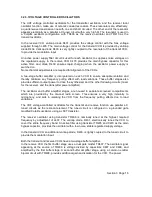
3.2.3.7 VOLTAGE CONTROLLED OSCILLATORS
The UHF voltage controlled oscillators for the transmitter excitation, and the receiver local
oscillator function, make use of ceramic coaxial resonators. These resonators are, effectively,
a quarter-wave transmission line with one end short circuited. The other end of the resonator
appears electrically as a parallel L-C tuned circuit with a very high Q. The resonator is used in
a Colpitts oscillator configuration with TR406 as the receive oscillator and TR410 as the
transmit oscillator.
In the receive VCO, varicap diode D431 provides the voltage control with the bias voltage
supplied through L405. The main voltage control for the transmit VCO is provided by varicap
diode D434. Varicap diode D433 is very lightly coupled to the resonator of the transmit VCO,
to provide the modulation input.
An active power supply filter circuit is used for each oscillator, to suppress noise voltages on
the regulated supply. In the receive VCO C470 provides the main bypass capacitor for this
active filter, and diode D430 ensures rapid charging when the oscillator power supply is
switched on.
No mechanical adjustments are required for alignment of the VCOs.
A two-stage buffer amplifier is incorporated on each VCO to ensure adequate isolation and
thereby minimize any frequency pulling effect with load variations. These buffer stages also
provide sufficient output power to drive the synthesizer and the other following circuits (mixer
for the receiver, and the transmitter power amplifier).
The oscillator and buffer amplifier stages, are housed in separate screened compartments
which are provided by the die-cast radio screen. This ensures a very high immunity to
microphony, and aids in isolating the VCO from the frequency pulling effects due to load
variations.
The VHF voltage-controlled oscillators for the transmit and receive function use parallel L-C
tuned circuits as the resonant element. The tuned circuit is configured in a grounded gate
modified Colpitts oscillator, using a JFET transistor.
The receiver oscillator using transistor TR406 is nominally tuned at the highest required
frequency by adjustment of L407. The varicap diode, D431, electronically tunes the VCO to
cover the entire frequency band. An active filter using transistor TR405 and C470 as the main
bypass capacitor, provides the oscillator with a low noise, stable regulated supply voltage.
In the transmit VCO an additional varicap diode, D433, is lightly coupled to the tuned circuit to
provide the modulation input.
Both the transmit and receive VCOs have a two-stage buffer amplifier.
In the receive VCO the first buffer stage uses a dual gate mosfet TR407. The oscillator signal
appearing at the source of TR406 is voltage divided by capacitors C487 and C488, and
amplified by the first buffer stage. A second buffer amplifier stage, using a common emitter
bipolar circuit with TR408, provides additional gain and isolation for the VCO. The power
Section 3 Page 16
















































